根据每个句子所表达的意思判断下列句子使用修饰语是否正确 The students quickly became frustrated by the homework that the teacher assigned. (You mean that the students became frustrated quickly, maybe because the homework was difficult or very long.)
题目
根据每个句子所表达的意思判断下列句子使用修饰语是否正确 The students quickly became frustrated by the homework that the teacher assigned. (You mean that the students became frustrated quickly, maybe because the homework was difficult or very long.)
相似考题
参考答案和解析
更多“根据每个句子所表达的意思判断下列句子使用修饰语是否正确 The students quickly became frustrated by the homework that the teacher assigned. (You mean that the students became frustrated quickly, maybe because the homework was difficult or very long.)”相关问题
-
第1题:
Cherry, what do you think of today’s English homework?().
A. A little difficult.
B. The teacher assigned a lot.
C. No problem.
参考答案:A
-
第2题:
根据下面材料,回答第 21~25 题:
Homework has never been terribly popular with students and even many parents, but in recent years it has been particularly scorned. School districts across the country, most recently Los Angeles Unified, are revising their thinking on his educational ritual. Unfortunately, L.A. Unified has produced an inflexible policy which mandates that with the exception of some advanced courses, homework may no longer count for more than 10% of a student’s academic grade.
This rule is meant to address the difficulty that students from impoverished or chaotic homes might have in completing their homework. But the policy is unclear and contradictory. Certainly, no homework should be assigned that students cannot do without expensive equipment. But if the district is essentially giving a pass to students who do not do their homework because of complicated family lives, it is going riskily close to the implication that standards need to be lowered for poor children.
District administrators say that homework will still be a pat of schooling: teachers are allowed to assign as much of it as they want. But with homework counting for no more than 10% of their grades, students can easily skip half their homework and see vey little difference on their report cards. Some students might do well on state tests without completing their homework, but what about the students who performed well on the tests and did their homework? It is quite possible that the homework helped. Yet rather than empowering teachers to find what works best for their students, the policy imposes a flat, across-the-board rule.
At the same time, the policy addresses none of the truly thorny questions about homework. If the district finds homework to be unimportant to its students’ academic achievement, it should move to reduce or eliminate the assignments, not make them count for almost nothing. Conversely, if homework does nothing to ensure that the homework students are not assigning more than they are willing to review and correct.
The homework rules should be put on hold while the school board, which is responsible for setting educational policy, looks into the matter and conducts public hearings. It is not too late for L.A. Unified to do homework right.
第 21 题 It is implied in paragraph 1 that nowadays homework_____.
[A] is receiving more criticism
[B]is no longer an educational ritual
[C]is not required for advanced courses
[D]is gaining more preferences
正确答案:A
-
第3题:
A suitable title for this text could be______.
[A]Wrong Interpretation of an Educational Policy
[B]A Welcomed Policy for Poor Students
[C]Thorny Questions about Homework
[D]A Faulty Approach to Homework
正确答案:D
-
第4题:
When a teacher asks the students to find some key words from a text quickly, he/she is intended to train students' __________strategy in reading class.A. skimming
B. scanning
C. extensive reading
D. intensive reading答案:B解析:考查阅读教学。scanning“寻读”,可以帮助学生快速找到所需信息,准确定位。故选B。skimming“略读”,快速浏览文本,掌握文章大意。extensive reading"泛读”,是指进行广泛、大量的阅读.可以使学生通过频繁地接触语言材料,自觉或不自觉地学到或掌握大量词汇,开阔学生的视野。intensive reading"精读”.是指深入细致、逐字逐句地阅读,可以通过深入钻研.加深知识的积累,、 -
第5题:
When a teacher asks the students to find some key words from a text quickly, be/she areintended to train students'_________ strategy in reading class.A.skimming
B.scanning
C.extensive reading
D.intensive reading答案:B解析:考查阅读教学。scanning“寻读”,可以帮助学生快速找到所需信息,准确定位。故答案选B。skimming“读”,快速浏览文本。掌握文章大意。extensive reading“泛读”,是指进行广泛、大量的阅读,可以使学生通过频繁地接触语言材料。自觉或不自觉地学到或掌握大量词汇,开阔学生的视野。intensive reading“精读”,是指深入细致、逐字逐句地阅读,可以通过深入钻研,加深知识的积累。 -
第6题:
The teacher spent almost the whole afternoon__________the students'homework.A.to go over
B.go over
C.going over
D.went over答案:C解析:暂无解析 -
第7题:
Text 1 Homework has never been terribly popular with students and even many parents,but in recently years it has been particularly scorned.School districts across the country,most recently Los Angeles Unified,are revising their thinking on this educational ritual.Unfortunately,L.A.Unified has produced an inflexible policy which mandates that with the exception of some advanced courses,homework may no longer count for more than 10%of a student's academic grade.This rule is meant to address the difficulty that students from impoverished or chaotic homes might have in completing their homework.But the policy is unclear and contradictory.Certainly,no homework should be assigned that students cannot complete on their own or that they cannot do without expensive equipment.But if the district is essentially giving a pass to students who do not do their homework because of complicated family lives,it is going riskily close to the implication that standards need to be lowered for poor children.District administrators say that homework will still be a part of schooling;teachers are allowed to assign as much of it as they want.But with homework counting for no more than 10%of their grades,students can easily skip half their homework and see very little difference on their report cards.Some students might do well on state tests without completing their homework,but what about the students who performed well on the tests and did their homework?It is quite possible that the homework helped.Yet rather than empowering teachers to find what works best for their students,the policy imposes a flat,acrosstheboard rule.At the same time,the policy addresses none of the truly thorny questions about homework.If the district finds homework to be unimportant to its students'academic achievement,it should move to reduce or eliminate the assignments,not make them count for almost nothing.Conversely,if homework matters,it should account for a significant portion of the grade.Meanwhile,this policy does nothing to ensure that the homework students receive is meaningful or appropriate to their age and the subject,or that teachers are not assigning more than they are willing to review and correct.The homework rules should be put on hold while the school board,which is responsible for setting educational policy,looks into the matter and conducts public hearings.It is not too late for L.A.Unified to do homework right.23.According to Paragraph 3,one problem with the policy is that it may_____A.discourage students from doing homework
B.result in students'indifference to their report cards
C.undermine the authority of state tests
D.restrict teachers'power in education答案:A解析:细节题【命题思路】这是一道局部细节题,需要对文章第三段的具体信息进行锁定,从而把握现在实行的政策所存在的问题。【直击答案】根据题干直接定位到第三段,该段第二句出现了显性转折but,该句认为:由于家庭作业在成绩中所占的比例不超过10%,学生很可能少做一半的作业,并且在成绩单上也不会有什么差别。A项“不鼓励学生做家庭作业”是对“作业在成绩中所占比例不超过10%”的同义替换。【干扰排除】B项利用indifference“漠不关心”对原文概念difference“差别,差异”进行形近干扰,属于偷换概念。C项的干扰来自本段第三句,该句阐述此项政策的实施无法让人知晓家庭作业对学生的国家考试有无重要影响,但是并未谈及该政策会削弱国家测试的权威性,属于无中生有的信息。D项偷换概念,本段末句的前半句提到“没有赋予教师权利找到适合学生的方法”,并非指D项的“限制了教师的教育权力”。 -
第8题:
小学英语?语音
一、考题回顾

二、考题解析
【教案】
Teaching aims:
Knowledge aim:
Students will master the meaning and pronunciation of the word.
Ability aim:
Students will know how to pronounce “-er” in words.
Emotional aim:
Students will be interested in learning English.
Key and difficult point:
Key Point:
Students will master the meaning and pronunciation of the word.
Students will know how to pronounce “-er” in words.
Difficult Point:
Students will be interested in learning English.
Teaching procedure:
Step 1: Warming-up
1. Greetings.
2. Sing a song Finger Family.
Daddy finger, daddy finger, where are you?
Here I am, here I am, how do you do?
Mommy finger, mommy finger, where are you?
Here I am, here I am, how do you do?
Ask them if they know the name of the song. Then may guess it is Finger Family. Then tell them that we are going to learn some pronunciation in “finger”.
Step 2: Presentation
1. Use some riddles to introduce the words. For example, “I will drink it every day. What is it? Yes, it’s water.” Then draw the according pictures(introduce “sister” by explaining its meaning). And write the words at last.
2. Ask the students to read the words after the teacher for twice. Then play high and low voice. If the teacher speak one word loudly, the students should speak it lowly, and vice versa.
3. Ask students to find similarities among the words. They may say that they all contain “-er” at the end of the words. Then introduce the rules of the pronunciation.
4. Ask students if they know other words containing “-er”. They may say “winter”, “river” or others.
Step 3: Practice
1. Finish Read, underline, and say in the textbook. Check answers, and ask students to read after the teacher.
2. Finish Look, listen and write in the textbook. Then invite students share their answers on the blackboard. Give encouragement.
Step4: Production
1. Ask students to make up a chant using the words we learned. For example:
Water, water, tiger likes water.
Sister, sister, sister likes computer.
Dinner, dinner, let’s have dinner.
Step5: Summary and Homework
Summary: ask a student to conclude the content of the lesson and summarize with the whole class.
Homework: chant for the students’ parents.
Blackboard design:
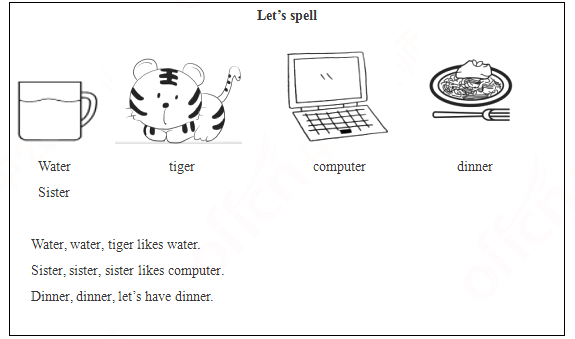
1. What is a good pronunciation lesson?
2. What will you do if one of the students in your class doesn’t do homework?答案:解析:1.
A good pronunciation lesson should make students master the rules of the pronunciation, and they can apply the rules when encounter the syllables in the future. So in my lesson, I firstly let the students find similarities among the words, then I conclude the rules. After that, I ask them if they know other words that share the same pronunciations. Later, few exercises are conducted so that they can consolidate the knowledge. Thus, I believe I have given a good pronunciation lesson.
2.
Firstly, I will ask him or her to finish the homework as soon as possible. Secondly, I will try to talk with the student patiently to figure out the reason. If the student say that they have too much homework, then I will try to reduce the homework amount afterward. If the student think homework is not important, I will tell that homework is a good way to absorb the knowledge learned today, otherwise they will forget it quickly. Lastly, I will talk to his or her parents to let them also focus on the problem and address it together with us. -
第9题:

二、考题解析
【教案】
Teaching aims:
Knowledge aim: Students can understand the pronunciation of “ear”, and get some simple spelling rules.
Ability aim: Students can read the words with the pronunciation of “ear” correctly by listening and speaking. Ability of listening and speaking will be improved.
Emotional aim: Students can increase their interests in learning English.
Key and difficult point:
Key points: Students can understand the pronunciation of “ear”, and how how to read the words contain “ear”, such as hear, near and etc.
Difficult points: Students can master the pronunciation of “ear” and read the related words correctly.
Teaching procedure:
Step 1: Warming-up
Greeting the students.
Sing a song: Head shoulder keens and toes.
Step 2: Presentation
1. Show the chant and ask the students the question: Can you find the same letter combination in these words?
2. Listen to the tape and let students pay attention to the pronunciation of “ear”, and then ask the students question: what does “ear” sounds like in these words?
3. Teacher the pronunciation of “ear” ,and let students pay attention to the teacher’s mouth.
4. Game: Play the finger show to practice the new words.
Step 3: Practice
Find more words with “ear” such as tear, dear, clear... and ask students to try to read by themselves and then invite some of them to share with the class. The teacher should act the role of monitor.
Step4: Production
1. Ask students to make up their own sentences by using the words learned today, such as “He hears the bad news,and then his tears falls down. ”.
2. Reading competition: let students to read the chant as quickly as possible, and then let students choose the best one.
Step5: Summary and homework
1. Summary: ask students summary what have learned in the class.
2. Homework:
(1) read these word after class.
(2) Find more words with “ear” and make another chant.
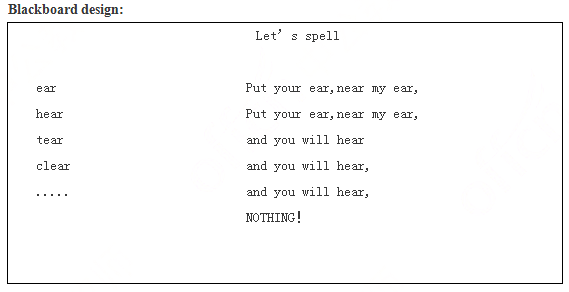 答案:解析:暂无解析
答案:解析:暂无解析 -
第10题:
一、标题不可缺少
What are you doing?
二、教学目标撰写要以学生为主语
Teaching aims:
(1) Knowledge aims
Students can master the key sentence structure “what are you doing?” .
(2) Ability aims
Students can communicate with their partners by using the new sentence.
(3)Emotional aims
Students will be more interested in sharing their ideas with others and take part the group activity.
Teaching key point
Master the new sentence structure.
Teaching difficult point
Describe what other people are doing.
Teaching Methods:
Situational teaching method, task-based teaching method
Teaching Aids:
PPT
三、教学过程要完成清晰
Teaching procedure
Step 1 Warming-up
At the beginning of class, ask students a question about what do they usually do on weekend. Students may have different answer like go to the zoo, stay at home and so on. Then teacher ask: “do you want to know what others are doing now?” to lead to the topic today, and write it down on the blackboard.
(step can give students chances to speak English ,and get a good preparation for the next step—the presentation part, student’s interest will be aroused as they can share the things they know with others in English. It can also help nurture students’ confidence.)
Step 2 Pre-reading
Show the picture about the Larry’s home, letting students guessing what happened and predict the content about the reading material.
(Justification: guessing part will focus students’ attention on the main topic of the reading passage. It prepares students to think critically about the topic and provides them with the opportunity to connect some aspect of the topic to their own lives)
Step3while-reading
Fast-reading
Ask students to read the short passage quickly and conclude the main idea.
(Justification: train students’ reading ability of scanning for the general information of the passage.)
Careful reading
1.ask students to read the passage again and answer the following questions:
What is Larry doing?
What is dad doing?
What’s grandpa doing?
2. Ask students to finish the sentence on the textbook.
(Justification: in this part, students’ analyzing and summarizing ability can be trained. In the process of answering, students can get the detailed information, which can help students understand the sentence.)
Step4 post-reading
1.play the tape and ask students to read the short passage after the tape and pay attention to the pronunciation of the words and sentences.
2.let students do the group work, it is a role play, four in a group. One of them call another one and ask what he or she is doing. After that, volunteers can show their performance before the class.
(Justification: this part can activate the atmosphere of the class and arouse students’interest at the same time. It helps students strengthen what they have learned during this lesson.)
Step 5summary and homework
Summary: do the summary together with students and let them have a clear clue about what we have learned
Homework: try to use the new knowledge to communicate with their partners after class.
(Justification: summary and homework can help students consolidate the knowledge what they have learned in the class, the homework can train students ability )
四、板书设计不可少
Blackboard design:
What are you doing?
What is Larry doing?
What is dad doing?
What’s grandpa doing?答案:解析: -
第11题:
单选题“On the whole,” Ms. Dennis remarked, “engineering students are lazier now than they used to be. I know because fewer and fewer of my students regularly do the work they are assigned.” The conclusion drawn above depends on which of the following assumptions?AEngineering students are working less because, in a booming market, they are spending more and more time investigating different job opportunities.
BWhether or not students do the work they are assigned is a good indication of how lazy they are.
CEngineering students should work harder than students in less demanding fields.
DMs. Dennis’ students are doing less work because Ms. Dennis is not as effective a teacher as she once was.
ELaziness is something most people do not outgrow.
正确答案: B解析:
文段中丹尼斯女士根据:越来越少的学生做布置给他们的工作这一现象,得出结论:工程学的学生更懒了,所以可知丹尼斯女士以学生完成布置给他们的工作的情况来衡量学生的勤奋程度,故B项是正确的。 -
第12题:
单选题We learn from the passage that _____.AChuck’s students are not clever enough
Bthe students didn’t do Chuck’s homework
CChuck Wall is an unusual teacher
Dno students enjoyed Chuck’s homework
正确答案: C解析:
根据文章的主要内容可知,教授之所以不同寻常,是因为它留作业的方式。故C选项正确。 -
第13题:
The more the young students worked, the ________ energetic they became.
A: much
B: more
C: most
D: very
参考答案:B
-
第14题:
L.A.Unified has made the rule about homework mainly because poor students_____.
[A]tend to have moderate expectations for their education
[B]have asked for a different educational standard
[C]may have problems finishing their homework
[D]have voiced their complaints about homework
正确答案:C
-
第15题:
All of the students are__________(suppose) to hand in their homework on time.
正确答案:
supposed -
第16题:
When a teacher asks the students to find some key words from a text quickly, he/she is intended to train students' __________strategy in reading class.A.skimming
B.scanning
C.extensive reading
D.intensive reading答案:B解析:考查阅读教学。scanning“寻读”,可以帮助学生快速找到所需信息,准确定位。故选B。skimming“读”,快速浏览文本,掌握文章大意。extensive reading"泛读”,是指进行广泛、大量的阅读.可以使学生通过频繁地接触语言材料,自觉或不自觉地学到或掌握大量词汇,开阔学生的视野。intensive reading"精读”.是指深入细致、逐字逐句地阅读,可以通过深入钻研.加深知识的积累,、 -
第17题:
The () teacher punishes his students when they don't do their homework or talk in class.A.spiritual
B.specific
C.strict
D.stressed答案:C解析:这名严格的老师在学生不做作业或者上课讲话时,他就处罚他们。 -
第18题:
Text 1 Homework has never been terribly popular with students and even many parents,but in recently years it has been particularly scorned.School districts across the country,most recently Los Angeles Unified,are revising their thinking on this educational ritual.Unfortunately,L.A.Unified has produced an inflexible policy which mandates that with the exception of some advanced courses,homework may no longer count for more than 10%of a student's academic grade.This rule is meant to address the difficulty that students from impoverished or chaotic homes might have in completing their homework.But the policy is unclear and contradictory.Certainly,no homework should be assigned that students cannot complete on their own or that they cannot do without expensive equipment.But if the district is essentially giving a pass to students who do not do their homework because of complicated family lives,it is going riskily close to the implication that standards need to be lowered for poor children.District administrators say that homework will still be a part of schooling;teachers are allowed to assign as much of it as they want.But with homework counting for no more than 10%of their grades,students can easily skip half their homework and see very little difference on their report cards.Some students might do well on state tests without completing their homework,but what about the students who performed well on the tests and did their homework?It is quite possible that the homework helped.Yet rather than empowering teachers to find what works best for their students,the policy imposes a flat,acrosstheboard rule.At the same time,the policy addresses none of the truly thorny questions about homework.If the district finds homework to be unimportant to its students'academic achievement,it should move to reduce or eliminate the assignments,not make them count for almost nothing.Conversely,if homework matters,it should account for a significant portion of the grade.Meanwhile,this policy does nothing to ensure that the homework students receive is meaningful or appropriate to their age and the subject,or that teachers are not assigning more than they are willing to review and correct.The homework rules should be put on hold while the school board,which is responsible for setting educational policy,looks into the matter and conducts public hearings.It is not too late for L.A.Unified to do homework right.
As mentioned in Paragraph 4,a key question unanswered about homework is whether_____A.it should be eliminated
B.it counts much in schooling
C.it places extra burdens on teachers
D.it is important for grades答案:B解析:推理题【命题思路】这是一道开封闭式推理题,需要对文章第四段阐述的具体信息进行锁定,从而推断出该项政策一个尚未解决的问题。【直击答案】根据题干关键词“a key question unanswered”定位至第四段的首句,该句提到,这项政策并未解决任何与家庭作业相关的真正棘手的问题。而这个问题的具体内容则是从“if”开始说明。从这两句的内容中可以得出家庭作业重要与否尚无定论,B项就是对该句两方面的高度概括,故为正确选项。【干扰排除】A项属于过度推理,无视条件性。文章中虽提到:“If the district…”,但是如果A项成立,必须满足“If”这个条件,即家庭作业对学生不重要。C项属于过度推理,本段末句提及这项政策没有确保教师布置的家庭作业没有超过他们愿意批改的数量,强调“意愿问题”,而C项强调“负担问题”。D项属于过度推理,本段第三句提到了学习成绩方面的问题,但是并没有说“如果家庭作业不重要的话,就不要在成绩中占重要比例”。所以D项无法与原文实现“是”与“否”的匹配。 -
第19题:
Text 1 Homework has never been terribly popular with students and even many parents,but in recently years it has been particularly scorned.School districts across the country,most recently Los Angeles Unified,are revising their thinking on this educational ritual.Unfortunately,L.A.Unified has produced an inflexible policy which mandates that with the exception of some advanced courses,homework may no longer count for more than 10%of a student's academic grade.This rule is meant to address the difficulty that students from impoverished or chaotic homes might have in completing their homework.But the policy is unclear and contradictory.Certainly,no homework should be assigned that students cannot complete on their own or that they cannot do without expensive equipment.But if the district is essentially giving a pass to students who do not do their homework because of complicated family lives,it is going riskily close to the implication that standards need to be lowered for poor children.District administrators say that homework will still be a part of schooling;teachers are allowed to assign as much of it as they want.But with homework counting for no more than 10%of their grades,students can easily skip half their homework and see very little difference on their report cards.Some students might do well on state tests without completing their homework,but what about the students who performed well on the tests and did their homework?It is quite possible that the homework helped.Yet rather than empowering teachers to find what works best for their students,the policy imposes a flat,acrosstheboard rule.At the same time,the policy addresses none of the truly thorny questions about homework.If the district finds homework to be unimportant to its students'academic achievement,it should move to reduce or eliminate the assignments,not make them count for almost nothing.Conversely,if homework matters,it should account for a significant portion of the grade.Meanwhile,this policy does nothing to ensure that the homework students receive is meaningful or appropriate to their age and the subject,or that teachers are not assigning more than they are willing to review and correct.The homework rules should be put on hold while the school board,which is responsible for setting educational policy,looks into the matter and conducts public hearings.It is not too late for L.A.Unified to do homework right.
L.A.Unified has made the rule about homework mainly because poor students______A.tend to have moderate expectations for their education
B.have asked for a different educational standard
C.may have problems finishing their homework
D.have voiced their complaints about homework答案:C解析:细节题【命题思路】这是一道局部细节题,需要对文章第二段具体信息进行锁定,本题主要考查考生对于上下文逻辑关系的理解。【直击答案】基于题干内容,结合出题顺序和行文顺序一致的原则,可初步定位至第二段首句。题干信息“made the rule about homework mainly because”和该句“This rule is meant to(规定的目的)”相对应,“poor students”则和该句的“students from impoverished or chaotic homes”相对应,所以正确选项应该表达“这些学生在完成家庭作业时可能有困难”,故C项为正确答案。【干扰排除】A项与本文主题homework无关,属于无中生有。B项干扰信息来自本段最后一句,表达“可能暗示……”,但并没有“已经要求……”,属于无中生有。D项属于无中生有,该段第二句提及了“可能会导致他们的抱怨情绪”,但原文并没有说“学生已经表达了他们的抱怨情绪”。 -
第20题:

二、考题解析
【教案】
Teaching aims
Knowledge aim: students will know the pronunciation of the group of letter “ear”.
Ability aim: students can read words with “ear” when they learn vocabulary.
Emotional aim: students will be more interested in speaking English.
Key and difficult points:
How to pronounce the group of letter “ear”.
Teaching procedure:
Step 1: Warming-up
After greeting students, the teacher plays a game to warm up the class: I say you point. The teacher speaks out a certain part of the body and students point it quickly. For example: point your eye! Point your ear! Point your hand!
Step 2: Presentation
Draw a ear on the blackboard and ask students what it is. Write down the word. Then ask what ears can be used to, and they will say we use ear to hear something. Write down word “hear”. Then do the action of hearing and put hands near the ear, and write down the word “near”.
Ask students to read the three words after the teacher, and find out the similarity among them. After discussion, they will say all these words have “ear”. Then ask students how to pronounce this group of letter. We will know it pronounce as /ir/.
Step 3: practice
Give students some other words with the group of letter “ear” and ask students to read them by groups. For example, a sentence “my dear, your tear is clear in my mind for years”. Then students can have a brainstorming and think of more words with “ear”.
Play a game Hot potato to practice these words. The teacher plays a piece of music. When the music is playing, students pass the ball from one to another. When the music stops, the one who gets the ball should read words on the blackboard.
Step4: Production
Do a chant with students: put your ear, near my ear, and you will hear, and you will hear, and you will hear, NOTHING!
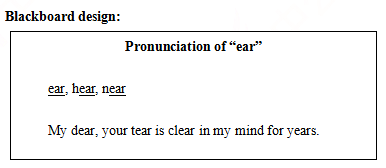 答案:解析:暂无解析
答案:解析:暂无解析 -
第21题:

二、考题解析
【教案】
Teaching Aims:
Knowledge aim: Students will be able to describe their summer holiday and acquire some knowledge about listening strategies.
Ability aim: Students can obtain the main idea quickly from the listening material and develop the ability of grasping detail information.
Emotional aim: Students can foster their interest and desire of learning English, and be fond of taking part in kinds of practical activities.
Teaching Key Points:
Students can get the main idea and useful information from the listening material.
Teaching Difficult Points:
Students can apply these skills in their listening and apply these expression in their daily communication.
Teaching Methods:
Communicative teaching method, task-based teaching method, audio-lingual teaching method.
Teaching Aids:
PPT, Blackboard, recorder and so on
Teaching Procedures:
Step 1: Warming up
1.Greetings
2.Sing an English song Summer Holiday, invite the whole students to clap when singing together and lead to the topic.
Step 2: Pre-listening
1.Brainstorm: Give students 3 minutes to say something about summer holiday as much as they can.
2.Clean up obstacle:Use pictures to teach students some difficult words or explain some words by English explanation.
Step 3: While-listening
1. Listen to the tape for the first time and ask them what the passage is mainly about, then let students share their ideas.
2.Listen to the tape for the second time and ask them to fill in the chart, then invite them to share their answers.
Step 4: Post-listening
1.Discussion: Ask students to discuss what they will do this summer holiday with their partners, and teacher will give them 3 minutes to prepare it and 3 minutes later, invite some students to share their own summer holiday in the front.
2.Report: Let students to write down plans of their own summer holiday with the key words and key sentences that they have learned today, 8 minutes later teacher invites some students to share the result of their reports.
Step 5: Summary & Homework
Summary : Invite a little teacher to help teacher make a summary of this class.
Homework: Let students prefect their plans of summer holiday and share with their parents.
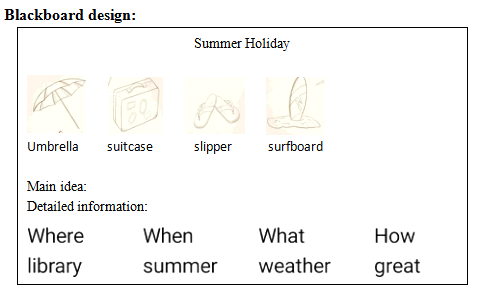 答案:解析:暂无解析
答案:解析:暂无解析 -
第22题:
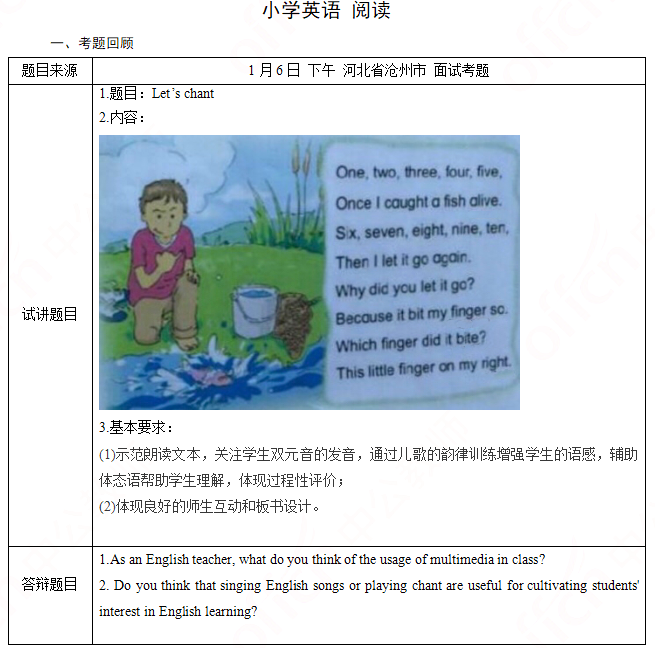
二、考题解析
【教案】
Teaching aims:
Knowledge aim:
Students will master the sound /ai/ in the words “five”, “alive” and so on.
Ability aim:
Students will apply the sound correctly in real communication.
Emotional aim:
Students will be more interest in speaking English.
Key and difficult point:
Key Point: Students will master the sound /ai/ in the words “five”, “alive” and so on.
Difficult Point: Students will apply the sound correctly in real communication.
Teaching procedure:
Step 1: Warming-up
1. Greetings.
2.Play a chant they have learned “tomato, tomato, wash, wash, wash” and lead them to learn another chant this class..
Step 2: Presentation
1. Students watch the picture and tell the teacher what they can see in the picture, and the teacher guide them to present the first part of the chant. Then students watch the picture carefully and predict what’s wrong with the boy, then the teacher guide them to present the last part of the chant.
2. Students observe the sentences and find out what common letters they can find.
3. The teacher teaches them correct pronunciation of the letter “i” in “five”, “right” and so on.
Step 3: Practice
1. Read the pronunciation /ai/ and the words that includes “i” repeatedly.
2. Listen to the tape and follow the tape, paying attention to the intonation of the chant.
3. Students work in pairs to make a chant in 5 minutes.
Step4: Production
1. The teacher writes more words that includes the sound /ai/and students try to read them.
2. Students work in groups to make a story using the picture and the words with the sound /ai/ on the blackboard.
Step5: Summary and Homework
Summary: ask a student to conclude the content of the lesson and summarize with the whole class.
Homework: ask students to search other pronunciation of the letter “i” and list those words accordingly.
Blackboard design:

1. As an English teacher, what do you think of the usage of multimedia in class?
2. Do you think that singing English songs or playing chant are useful for cultivating students' interest in English learning?答案:解析:1.
Multimedia help students to understand our class more smoothly and vividly and enhance their thinking ability. With images, audios and videos, knowledge that is difficult to understand in English is well presented. The students can more truly feel the content of the text, which is helpful to solve difficulties. In the environment of multimedia students can also develop abstract thinking and divergent thinking.
2.
As far as the activity such as singing or chant itself is concerned, it is very interesting and can attract students' attention. The time for students to keep concentrating is limited. If you add such activities as some songs and chants that students like, you can not only attract students' attention, but also cultivate their interest in learning. Therefore, combining knowledge and activities in the classroom allows students to learn while playing and even achieve better effects. -
第23题:
单选题The problem()when the students refused to do their homework.Aarose
Baroused
Crose
Draised
正确答案: C解析: 暂无解析 -
第24题:
单选题Why did the flames spread quickly?AThe oven became very hot.
BThe houses were close together.
CThe baker did nothing to stop it.
DThe baker’s house was burning quickly.
正确答案: C解析:
推理判断题。题干问“大火为什么迅速蔓延?”由文章第二段倒数第二句“…and then the flames had quickly spread to the other houses in the narrow lane.”中的“narrow lane”可推知,这是一个狭窄的小巷,房子一定挨得很紧。
